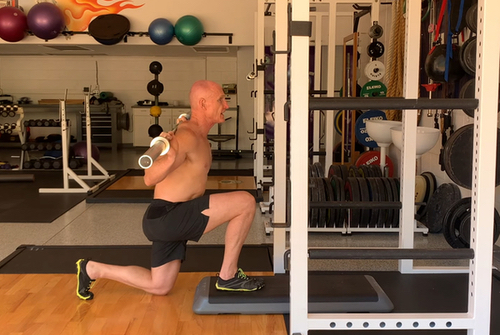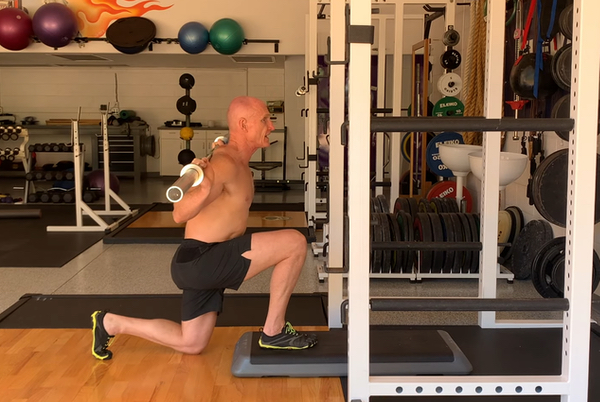
It’s been a long time since my last blog/vlog in the gym, so I thought it was way past due to get back there!
This week’s exercise — the box lunge — is a great one for athletes playing sports or performing movements where it’s important to get low (wrestling or hockey).
The box lunge is also good for working on the need for strength coming off the bottom of a movement, whether it’s picking up heavy stones in weird and crazy positions (I do box dead lifts for those same reasons) or lifting boxes from one spot to another.
As always, you have to be very conscious about form because lifting heavy things creates a lot of stress on your body.
If you want to develop your gluteus maximus muscles, the box lunge is a good exercise. For beginners working on this exercise for the first time, it’s very important not to elevate your foot higher than 4 inches. When you get to the bottom position of the lunge, don’t let your shin go past the vertical position.
Why? Doing so diverts more load through the patella tendon, so you can create plenty of problems for yourself if your tissues aren’t conditioned to handle it.
For example, I’ve seen plenty of athletes traumatize the patella tendon, the insertion to the tibia or the quadriceps expansion all around the knee from pushing too hard and deep.
Once you get into that bent position, you’ve got so much hip flexion, your nervous system really has to activate the gluteus maximus to get you out of that position.
Remember, the gluteus maximus is not a muscle that’s easy to turn on, as it’s primarily composed of fast-twitch muscle fibers which have high thresholds of activation.
Your gluteus maximus muscle is designed for explosive, heavier movements (acceleration, deceleration, landing from a jump).

A good exercise as you age!
Performing these kinds of movements become much more important for people as they age too. As people slow down and become more sedentary, they stop stressing their bodies and lose the functionality in their gluteus maximus and core muscles so much faster.
I’ll show you how to perform the box lunge in a number of ways, including the split squat (an exercise I like to use when I’m building muscle) and a standard lunge.
You can do the box lunge with an aluminum bar as I show you in my vlog or with kettlebells.
One more thing: Don’t go too fast with this exercise! When stepping forward and your foot is raised (even 4 inches), you’re stretching your hip flexors on the trailing leg very significantly.
If your hip flexors are too tight, you’ll be pulled forward into bad form. Plus holding the bar too high puts a lot of stress on your neck too, so you really need enough flexibility in your hip flexors to maintain a balanced, stable position.
Starting out, I recommend performing this exercise with only your body weight, then build up to three sets ranging from 8-16 reps. Once, you’ve accomplished that without getting sore, you can move up to an empty bar, then weights.

If you’re interested in learning more about exercises like the box lunge, you may want to consider my Scientific Back Training and Scientific Core Conditioning e-courses.
Love and chi,
Paul





